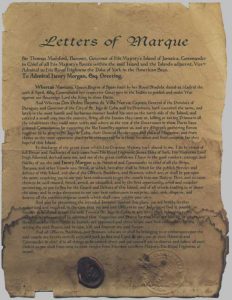A proposal to reintroduce the Letter of Marque
Luke Morton, Rob Morris, and I were having yet another robust discussion while taking a break from delivery of a three-day pilot innovation course to Special Operations Command personnel.
The course is an intensive and experiential innovation masterclass. A compressed adaptation of Stanford University’s ten-week Hacking 4 Defense course, and the direct result of our joint pitch to promote internal innovation at the Defence Entrepreneurs Forum in December 2017. It is also just one component of the bottom-up innovation pipeline that we are building to help make the ADO a more innovative organisation.
During the break, we were discussing the concept of ‘smart money’ within the venture capital industry, and how it might be adapted within the Australian Defence Organisation.
‘Smart money’ refers to going beyond just investing cash and providing the human network access, intangible resources, and hard-won wisdom required to solve commercial problems.
When entrepreneurs enjoy multiple competing offers from venture capital firms for their proposed solution to a problem, they will often choose the ‘smartest’ money because it helps them better overcome obstacles, seize opportunities, and generally assures them the best chance of success.
At this point we identified that one great obstacle that military innovators need to overcome is the organisational hierarchy, which presents as two problems. First, the people in our organisation are assigned only very narrow remits. Second, innovative work is highly vulnerable to veto from the chain of command because regardless of whether you convince a superior officer to support a project, there is always another above who can end your project.
This is really no different to any large corporate organisation, but it is totally different to the civil startup community. Except for highly regulated industries, startups never need to be approved. At most, they need to be resourced, and sometimes, they don’t even need that. Startups exist in a world of permissionless innovation.
Can we achieve permissionless innovation in the Australian Defence Organisation? The military hierarchy needs to remain, but can we provide a simple way of supporting grassroots innovators who will do good work if given the chance?
There is. Deep within Commonwealth military history is the precedent of the Letter of Marque:

A Letter of Marque was a licence issued by a sovereign to a privateer authorising the privateer to make reprisals on a hostile state during the Age of Sail.
Developing a true culture of innovation compels buy-in from the bottom up. But what those at the bottom of hierarchical systems lack is authority. Permissionless innovation will only get a soldier, sailor, or airman so far before crashing into a single “no”.
“Why join the Navy if you can be a Pirate?” Steve Jobs
Steve Jobs, the founder of Apple was quoted saying “Why join the navy when you can be a pirate?” This was most likely meant to convey that pirates have more freedom than sailors.
Why shouldn’t we equip our people with the freedom of maneuver essential to innovation?
This is where the Letter of Marque is worthy of being conceptually recycled. Instead of equipping privateers with a license to hunt pirates, let’s arm our own people with clearly defined and sanctioned authority within our organisation to hunt problems.
In fact, a contemporary Letter of Marque can be found in Steve Blank’s “Get to Yes” memo. In short, Steve Blank’s Get to Yes memo compels “yes” as the default answer with any “no” requiring a detailed answer to senior leadership reducing the hierarchical friction that hinders innovation.
Let’s reintroduce the Letter of Marque.

